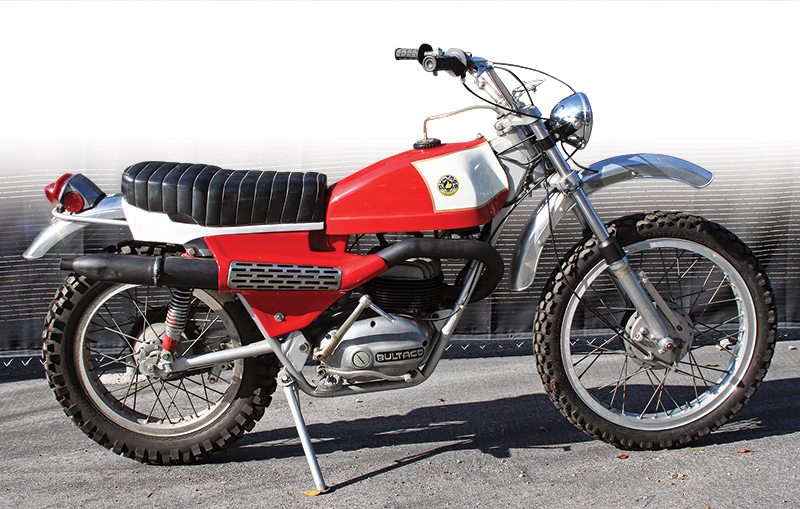
This Montadero was an adequate dual-purpose motorcycle, in truth, more focused on the dirt than the pavement, though the handling was a bit on the heavy side. It used a relatively old-fashioned piston-port two-stroke single, but the way the motor laid the power to the ground was impressive. All part of the Spanish mystique.
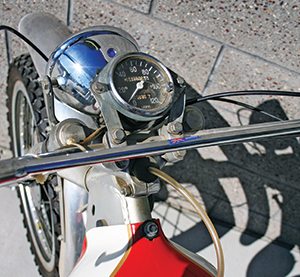
Back in the late ’60s, the name Bultaco was well known at any race, be it off-road or on-road. The company had some superb product, all based on the two-stroke single-cylinder engine. On the pavement, the 250 Metralla (Shrapnel, in Spanish) was constantly on the podium, as with Bultaco’s one/two/three win at the ’67 Isle of Man Production TT. Off-road, the 250 Sherpa (as in Himalayan guide) was a wiz at winning trials, while the Pursang (Pure Blood) was proving its worth in the motocross world. For the less competitive riders, the dual-purpose 250 Matador was quite appealing.
If we back up a few years to the late ’50s, we find Francisco Bulto, nicknamed Paco, working for the Montesa firm and convinced that racing successes sold street bikes. The Montesa hierarchy disagreed, so Bulto went off on his own with a dozen Montesa staffers in tow. In 1959, his new company—Bult + aco—produced the first 125cc road-going Trallas (Whip). The little eighth-liter engine put out a commendable 12 horsepower at 6,500 rpm, a figure not to be sneezed at in 1960. In 1968, a serious motocrosser arrived, the Bandido 360, with a bore of 85mm, stroke of 64mm, for a capacity of 362cc. The Bandido had a new engine with a gear-driven primary that was mounted in a new frame, but the model wasn’t really competitive due to weight. What to do? Heck, easy, make it a dual-purpose model, and call it the Montadero, or Mountaineer.
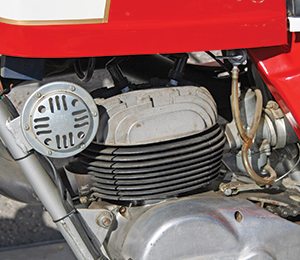
The first Montadero came and went quite quickly, as it was a bit too Bandido-like, too high-strung, to suit the cow-trailing American market. The Montadero Mark II followed; it was a genuine slogger, with a heavier flywheel and the engine timing making grunt rather than horsepower. Reviewers described the engine as having “four-stroke-like pulling ability”…no mean praise. It also had a bigger fuel tank, improved suspension, a slightly revised frame, and a sophisticated, waterproofed, electronic ignition.
Granted, this was still not for the average putt-putt kind of rider, but rather the real enthusiast who was eager to get out in the forest or desert and have a rollicking good time. No oil injection on this toughie; mix the right amount of the right oil into the gas in the tank. However, appreciating that the trailster would be out for a longer ride than a racer, the seat was comfy and there was lots of suspension.
The frame was a full double cradle, which added a bit of weight but also improved the handling. The Spanish Betor Company made the telescoping double-damped fork to Bultaco specs, with upwards of seven inches of travel. Betor also supplied the shock absorbers, with progressively wound springs and five-way preload adjustability.
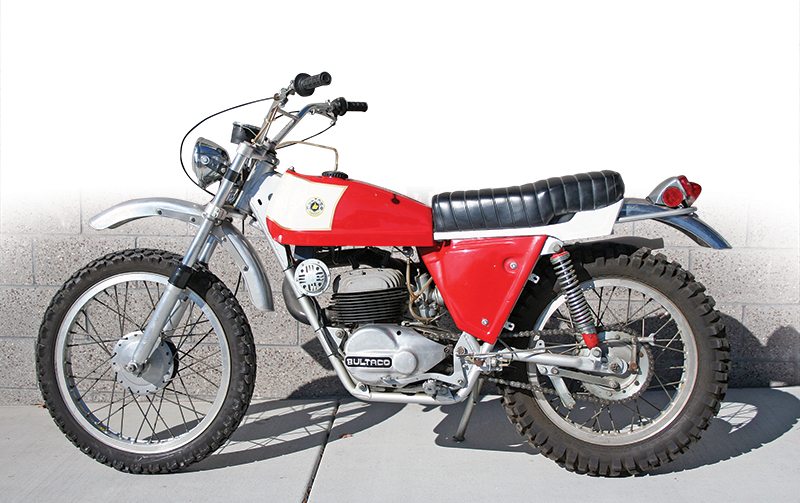
Wheels were 21-inch on the front, 19-inch on the rear, with a 3.00 tire on the front and 4.00 on the rear. Akront rims were spoked to lightweight alloy hubs. Brakes, not considered a terribly important item on a motorcycle of this nature, were smallish 5.5-inch single-leading-shoe items.

The engine was the centerpiece, securely bolted into the frame, aesthetically a beautiful piece of work with oval cases and a squat nine-finned cylinder. Horsepower, with its 10:1 compression ratio, was rated between 32 and 33 at 6,000 rpm, but more importantly peak torque was at a nominal 5,000 rpm. Do not forget that up until the mid-1960s, big British, low-revving thumpers were considered the bike of choice for off-road.
The carburetor was a Spanish-made Amal Concentric of 32mm, with the air cleaner high up and the breathers coming in from under the seat. Even in the event of a spill—and Bulto knew there would be many—no debris would get into the system. The ignition system was well protected in case of a water crossing. To keep the authorities happy, a little 6-volt battery could keep the lights on if the engine was not running. A magneto provided the spark through a coil, igniting the two spark plugs in the top of the cylinder head simultaneously and guaranteeing a thorough burn of the fuel charge. The CDI ignition meant that one never had to worry about gapping breaker points.
Helical gears ran the power back to the 4-speed transmission, with a spring-loaded cush-drive mounted on the end of the crankshaft. A sensible addition this was, as it was best to tone down all that abrupt on-and-off power, which could snap a final-drive chain.
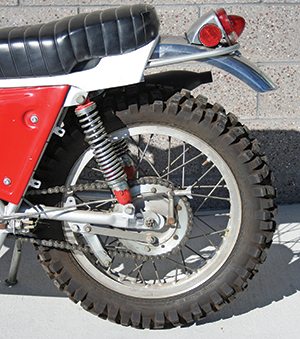
The dressing was sparse to suit the intent of the machine. A 3.4-gallon gas tank would give a range of 150 miles—but not much more. The right side panel hid the battery, and provided easy access to the washable air cleaner. Over on the right, the hot exhaust was hidden behind a large panel, quite effective in preventing burns in case of a spill. The sidestand was also on the right, an unusual placement, but one that kept it well-protected as the rider crashed through the woods. The lights were somewhat quickly detachable, for those who were serious about their boonie-bashing, and the only instrumentation was a speedometer and a high-beam indicator on the headlight.
Throw a leg over the 30-inch-high saddle. Gas on, tickle the carb, a couple of kicks to the starter. Engine fires, reasonably well muffled, snick the gear lever into first and let out the clutch with about 3,000 rpm on tap. Gobs of torque, in a two-stroke sense. Click, click, click—in fourth a rider could see 80-plus mph on the speedo. The Montadero 360 was a good bike, though short lived, at least as far as the name went. Bultaco, realizing the value of well-known labels, renamed it the Matador 360 in 1973.
(This Retrospective article was published in the February 2014 issue of Rider magazine.)









How much are they worth and selling for ? Looking for an El Bandito or El Montadero 360 to purshase
Ed, I have an original (frame and engine serial number matching) Bultaco El Bandido (Motocross version). I am near finished a complete original restoration of the bike. Contact me by email if you are still looking for an El Bandido.
Thanks,
Dwayne
I’ve got a 1970 El Bandido for sale.
Hello Charles- just saw this article. Still have the 1970 bike for sale? Thanks!
Ive got one in my garden shed in seattle.